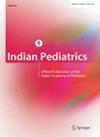Skin Damage Risk and its Severity Caused by Pulse Oximetery Saturation Probe Attachment in Preterm Neonates: A Prospective Observational Study from Western India.
IF 1.5
4区 医学
Q2 PEDIATRICS
引用次数: 0
Abstract
A six-month prospective study assessed 94 preterm neonates using neonatal skin condition score (NSCS) at the site of peripheral capillary oxygen saturation (SpO2) probe attachment. Skin damage (NSCS > 3) occurred in 70.21% of neonates at least once. The severity of skin injury was associated with lower gestational age, lower birth weight, and poor outcomes.
脉搏血氧饱和度探头附着引起的早产儿皮肤损伤风险及其严重程度:一项来自印度西部的前瞻性观察研究。
一项为期6个月的前瞻性研究使用新生儿皮肤状况评分(NSCS)在外周毛细血管氧饱和度(SpO2)探针附着部位评估94名早产儿。70.21%的新生儿至少发生一次皮肤损伤(NSCS bbbb3)。皮肤损伤的严重程度与低胎龄、低出生体重和不良结局有关。
本文章由计算机程序翻译,如有差异,请以英文原文为准。
求助全文
约1分钟内获得全文
求助全文
来源期刊

Indian pediatrics
医学-小儿科
CiteScore
3.30
自引率
8.70%
发文量
344
审稿时长
3-8 weeks
期刊介绍:
The general objective of Indian Pediatrics is "To promote the science and practice of Pediatrics." An important guiding principle has been the simultaneous need to inform, educate and entertain the target audience. The specific key objectives are:
-To publish original, relevant, well researched peer reviewed articles on issues related to child health.
-To provide continuing education to support informed clinical decisions and research.
-To foster responsible and balanced debate on controversial issues that affect child health, including non-clinical areas such as medical education, ethics, law, environment and economics.
-To achieve the highest level of ethical medical journalism and to produce a publication that is timely, credible and enjoyable to read.
 求助内容:
求助内容: 应助结果提醒方式:
应助结果提醒方式:


